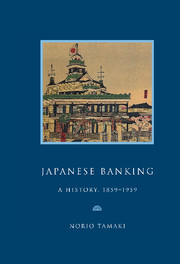Book contents
- Frontmatter
- Contents
- Preface
- Genealogy of leading Japanese banks, 1859–1959
- List of abbreviations
- Map
- Part I A bankrupt Shogunate, 1859–1868
- Part II The Meiji Restoration: monetary confusion and banking experiments, 1868–1881
- Part III Matsukata, the wizard of Japanese banking, 1881–1897; the Yokohama Specie Bank (1880) and the Bank of Japan (1882)
- Part IV The Japanese on the London money market, 1897–1911
- Part V War, the Japanese boom years, 1911–1919
- Part VI Crisis and the road to war, 1919–1937
- Historical background
- 21 Post-war collapse, 1919–1923
- 22 The 1923 catastrophic earthquake, 1927 financial disaster and the new Bank Act, 1923–1927
- 23 Financing heavy industries, 1927–1937
- 24 The challenge of militarism, and a change of roles for Nichigin and Shokin, 1929–1937
- Part VII Complete commitment, struggle and defeat, 1937–1945
- Part VIII American ‘democratisation’ and the search for growth, 1945–1959
- An extraordinary century, 1859–1959
- Appendices
- Notes
- Bibliography
- Index
22 - The 1923 catastrophic earthquake, 1927 financial disaster and the new Bank Act, 1923–1927
Published online by Cambridge University Press: 03 February 2010
- Frontmatter
- Contents
- Preface
- Genealogy of leading Japanese banks, 1859–1959
- List of abbreviations
- Map
- Part I A bankrupt Shogunate, 1859–1868
- Part II The Meiji Restoration: monetary confusion and banking experiments, 1868–1881
- Part III Matsukata, the wizard of Japanese banking, 1881–1897; the Yokohama Specie Bank (1880) and the Bank of Japan (1882)
- Part IV The Japanese on the London money market, 1897–1911
- Part V War, the Japanese boom years, 1911–1919
- Part VI Crisis and the road to war, 1919–1937
- Historical background
- 21 Post-war collapse, 1919–1923
- 22 The 1923 catastrophic earthquake, 1927 financial disaster and the new Bank Act, 1923–1927
- 23 Financing heavy industries, 1927–1937
- 24 The challenge of militarism, and a change of roles for Nichigin and Shokin, 1929–1937
- Part VII Complete commitment, struggle and defeat, 1937–1945
- Part VIII American ‘democratisation’ and the search for growth, 1945–1959
- An extraordinary century, 1859–1959
- Appendices
- Notes
- Bibliography
- Index
Summary
The Great Earthquake of 1923, metropolitan banks in ruin, 1923–1926
On 1 September 1923, at 11.58 a.m., a severe earthquake of 7.9 on the Richter scale hit the Pacific coast of Japan at Tokyo Bay in the area known as the southern Kanto district. This was the Great Kanto Earthquake, the most serious natural disaster ever to fall on Japan. The number of people affected was 3.4 million, of whom more than a hundred thousand died out of a total Kanto population of 11.8 million. Deaths were particularly heavy in Tokyo and Yokohama, which accounted for 65 per cent and 32 per cent of the dead and for 82 per cent and 17 per cent of the missing respectively. The government later estimated the aggregate amount of assets destroyed to be ¥4,570 million, which was 38 per cent of the national income of 1923. More than a third of these were burnt to ashes in the Great Earthquake.
The disastrous earthquake had major consequences for the Japanese banking system. On the day of the Great Earthquake, there were 542 bank offices in Tokyo comprised of 168 head offices and 374 branches, of which 285 offices, or 63 per cent, were burnt down. In Yokohama, where most of the banking offices in Kanagawa prefecture were concentrated, all forty-two offices, save for the Specie Bank head office, disappeared completely. In Tokyo, of the eighty-four member banks of the Tokyo Bank Association there survived only eight banks without serious damage including the head offices of the Hypotech Bank, Industrial Bank and Mitsubishi and the Tokyo branches of the Specie Bank, Bank of Taiwan and Sumitomo.
- Type
- Chapter
- Information
- Japanese BankingA History, 1859–1959, pp. 147 - 159Publisher: Cambridge University PressPrint publication year: 1995



